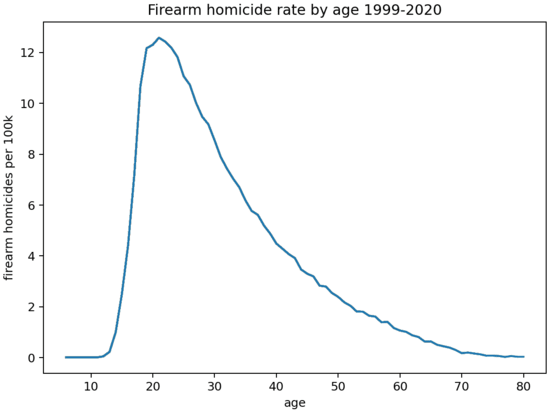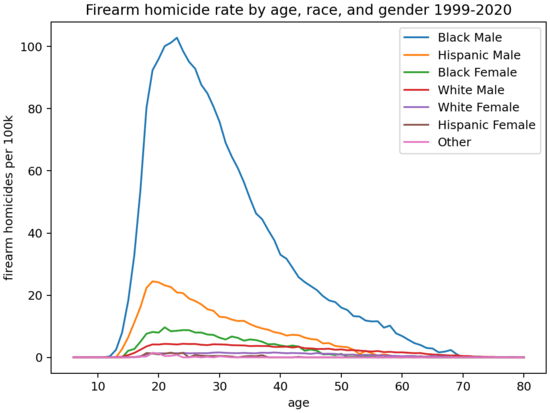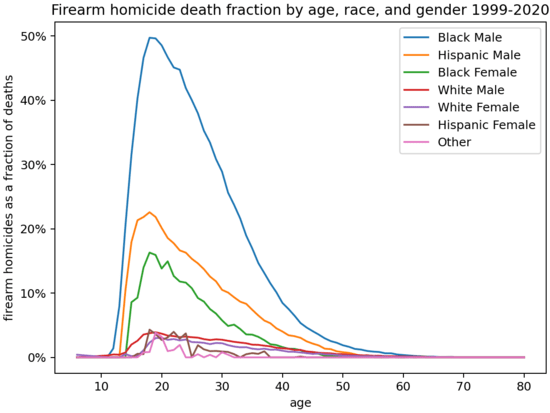Outrage and Statistics into Policy
post by jefftk (jkaufman) · 2023-04-10T14:00:01.280Z · LW · GW · 11 commentsContents
11 comments
Here's a pattern that doesn't work very well: a tragedy catches our attention, we point to statistics to show it's an example of a distressingly common problem, and we propose laws to address the issue. Except the event is rarely representative of the larger problem, and so these policy changes won't help much with the issues reflected in the statistics. Instead, we should combine the anger and passion the tragedy evokes with a deeper interpretation of the statistics to identify what changes we most need.
For example, with the recent Nashville school shooting a lot of people are giving statistics like how there were 600+ mass shootings and 51 school shootings in 2022, or how guns are now the largest cause of death for children. But let's look into the kind of events these statistics represent.
The Gun Violence Archive maintains a listing of mass shootings: incidents in which at least four people are shot. They link news stories for each, and while they're frustrating and depressing they're very rarely "someone senselessly shoots up an elementary school". Instead they're people fighting and one of them pulls out a gun, people arguing at a park and then escalating to shooting on the highway, or a targeted attack at a garage. In half of the incidents exactly four people are shot, since most shootings are fewer people and the cutoff is four.
Education Week maintains a listing of school shootings: incidents in which at least one person is shot on school property or a school bus. Looking over them they're again mostly not the kind that makes national news. Two teenagers fighting in the schoolyard and one of them has a gun, a drug deal between two armed people in a school parking lot escalates into a shooting, or an adult was shot in their car in the school parking lot after a basketball game.
If you look at the Nashville school shooting, or others that have made especially large impacts nationally, they're attacks against younger kids. And hearing the "number one cause of death among children" statistic you might think this is common. But "children" here is being used literally to mean "under 18": 47% of those dying were 17, and 76% were 16 or 17. Only 18% were under 15:
Source: CDC, code
None of this is to minimize the suffering and loss these shootings represent: ten incidents in which four people die isn't better than one in which forty die, and someone dying at 17 isn't more acceptable than dying at 9. All of these deaths are too many. But if we're going to make things better, we need to target our responses to the common cases, and not the unusual ones that make the news.
Here's the demographic breakdown:
And as a proportion of deaths at each age:
That the impact of these shootings so strongly reinforces existing disadvantage makes the misplaced focus especially tragic.
Translating this into policies, the efforts to re-ban assault rifles don't make sense: gun homicides are overwhelmingly from handguns. Same with red flag laws, where a judge can order someone's guns confiscated, since most of the homicides are via illegally possessed guns which could already be confiscated. An approach of enforcing existing laws on handgun possession, however, making it less likely that teenagers and young adults who get into fights will be armed, is the kind of policy that fits the bulk of the problem, and sounds much more likely to make an impact.
11 comments
Comments sorted by top scores.
comment by Dagon · 2023-04-10T16:58:07.394Z · LW(p) · GW(p)
This is not wrong, but it's a broken model of how information and policy is propagated and debated. One immediate concern is that you use the word "we" when discussing groups that don't contain me (nor you, I suspect).
a tragedy catches our attention, we point to statistics to show it's an example of a distressingly common problem, and we propose laws to address the issue.
Not true. The tragedy catches some people's attention, and they pick statistics that will gain them further attention and funding. That amplification catches more people's attention, but on slightly different topics than are justified. Still other people have ideas about what laws they'd like to see, and use this attention to justify their ideas and prevent rational discussion of it.
There is no "we" on such topics. Bootleggers and Baptists only.
comment by jaspax · 2023-04-10T14:30:47.334Z · LW(p) · GW(p)
I have wanted to write a similar post. I actually think that the two main clusters of school shootings are so different that they shouldn't even be considered the same thing. On the one hand we have shootings which have a small number of victims, usually involve handguns, and tend to be related in some way to urban gang violence; on the other hand we have the shootings with a large number of victims or intended victims, often involve assault rifles of some kind, and tend to be related to socially isolated individuals who justify their actions as some kind of revenge. (And your post made me more aware of a third category, which is acts of violence which by happenstance take place near a school, which really shouldn't count as the same thing.)
The former group makes up the vast majority of cases recorded as "school shootings" but gets essentially zero national press; the latter group is extremely rare relative to the former, but gets infinite coverage. But there is almost no overlap between the causes, means, and motives between the two groups, and things which will help one will do almost nothing for the other.
comment by evand · 2023-04-11T03:02:01.264Z · LW(p) · GW(p)
I feel like the argumentation here is kinda misleading.
Here's a pattern that doesn't work very well: a tragedy catches our attention, we point to statistics to show it's an example of a distressingly common problem, and we propose laws to address the issue.
The post promises to discuss a pattern. It's obviously a culture-war-relevant pattern, and I can see a pretty good case for it being one where all the examples are going to be at least culture-war-adjacent. It's an important pattern, if true, so far that seems justified and worth worrying about how to improve on.
But then the post provides one example. Is it a pattern? If so, what are the other cases, and why doesn't the post concern itself with them? If the post is about the pattern of mistakes and how to address them, and why this is a thing to worry about in general, shouldn't there be more like 3+ examples?
The case made that gun violence is not being addressed well, and is conflating at least two different but related problems, seems quite strong. It's a good read, and the statistics presented make a strong case that we're not addressing it well. I liked the argument presented, and felt better informed for having read the post (note to self: I should probably dig a bit deeper on the statistics, since the conclusion is one I'm pretty sympathetic to). But if that's the argument the post is going to make, why isn't the title / intro paragraph something more like "we're not addressing the main causes of gun violence" or "mass shootings that make headlines aren't central examples of the problem" or something like that?
I assume that the gun violence example is one case of many, and that there are both general and specific lessons to be learned. I assume it would be possible to over-generalize from one example, so looking for common features and common failures would be instructive.
Overall, it felt like the post made several good points, but that the structure was a bit of a bait and switch.
Replies from: jkaufman, ben-lang↑ comment by jefftk (jkaufman) · 2023-04-11T11:13:41.357Z · LW(p) · GW(p)
Fair! I was thinking of it as three instances, where we have three different statistics being used to support policy changes that don't fit their underlying causes, but you're right that they're all on gun policy.
Thinking a bit, here are two other cases where you see similar things:
-
Transportation, with people using "road deaths" to push for making buses safer after high-fatality crashes, even when buses are already far safer than cars and it's cars that are the reason for high road deaths (even adjusting for mode share)
-
Domestic hunger, where the examples people give are people starving, but the statistics are for food insecurity which is defined very broadly. I think it's likely that this is pushing us towards the wrong policies here but would need to look into this more.
↑ comment by jefftk (jkaufman) · 2023-05-18T12:25:03.439Z · LW(p) · GW(p)
Another example: using statistics about the frequency of abductions to argue that children should need to be pretty old before being on their own outside the house. Except a huge fraction of kidnapping is parental custody disputes, and if you're a parent making this decision you know whether that's a relevant concern.
↑ comment by Ben (ben-lang) · 2023-04-14T13:15:56.160Z · LW(p) · GW(p)
An example I think fits the pattern:
A serving London police officer used his badge and handcuffs to detain a young woman (Sarah Everard), he then raped her, murdered her and set fire to her body.
Since this absolutely awful case caught headlines various changes have been made to police policy. Several hundred officers are being investigated for crimes that (for some reason) were not previously investigated [1]. And the government brought in new laws against street harassment [2]. I support the changes (as far as I understand them) and I really don't understand why the police were not already investigating officers accused of serious sex crimes. But, it is still clear that the case of Sarah Everard is not a typical example of "street harassment" (its not an example at all), so mentioning her case in that discussion feels vaguely dishonest.
[1] https://www.bbc.co.uk/news/uk-63162881 [Police investigations]
[2] https://www.bbc.co.uk/news/uk-politics-65065154 [Street harassment bill linked to the murder]
[3] https://www.bbc.co.uk/news/topics/c8657zxk82wt?page=2 [A list of everything the BBC think links to the murder]
comment by philh · 2023-04-12T20:03:41.087Z · LW(p) · GW(p)
ten incidents in which four people die isn’t better than one in which forty die
Worth being explicit that the mass shooting incidents you spoke about above are ones where four or more people are shot. The number of deaths in a mass shooting incident can be zero.
This doesn't contradict anything you said, but I think it would be easy for someone to get the wrong impression.
comment by TAG · 2023-04-11T13:14:38.882Z · LW(p) · GW(p)
Translating this into policies, the efforts to re-ban assault rifles don’t make sense: gun homicides are overwhelmingly from handguns. Same with red flag laws, where a judge can order someone’s guns confiscated, since most of the homicides are via illegally possessed guns which could already be confiscated
So what's the rational thing to do?
a) Advocate the policies that would make the most difference, regardless of political feasibility.
b) Support some sort of compromise between what makes a difference, and what could get passed.
You are not yourself using a) style logic, because if you were you would call for handguns and assault rifles (and...) to be banned. That's the policy with the most impact, because the impact of an assault rifle ban isn't zero.
But consider the possibility that your opponents are applying (b) style logic themselves. Maybe they would like to ban handguns or all guns, but don't feel that they have a hope of passing the legislation.
If the only changes you can make politically are small changes ... why not make them, and get small benefits? There's a name for the opposite: "sacrificing the good to the perfect".
Replies from: jkaufman↑ comment by jefftk (jkaufman) · 2023-04-11T13:59:59.950Z · LW(p) · GW(p)
I think it's generally best to figure out what policies you think would be best, and then decide which ones to push for based on a combination of their impact-if-enacted and their feasibility.
In this case, I think enforcing existing regulations on handguns is both higher impact and higher feasibility than pushing to ban assault rifles. Banning all guns would be higher impact, but very low feasibility.
Replies from: lsanders, TAG↑ comment by lsanders · 2023-04-16T15:46:48.663Z · LW(p) · GW(p)
It’s not clear to me that putting effort into enforcing existing regulations is more feasible for many of the folks advocating assault rifle bans, nor is it clear to me that it’s a significantly higher impact approach.
Re: feasibility — Your examples of folks advocating additional legislation are federal and state politicians, while my impression is that most handgun enforcement actions in the U.S. traditionally rely on law enforcement agencies at more local levels. Thus, it’s not clear that the folks pushing such policies are in as good a position to affect the prioritization of handgun law enforcement, which (at least somewhat) counteracts the benefit of pursuing a less controversial remedy.
Also, in particular, the politicians you refer to are Democratic party politicians. The creation of gun laws is already a highly partisan issue in the United States, with Democratic party associated with efforts for more gun control and the Republican party associated more with gun rights. My impression is that enforcement of gun laws is currently seen as a much less political issue. If Democratic politicians start prominently pushing for shifting enforcement priorities toward a political goal of keeping guns off the street, I think that risks turning gun law enforcement policies into just another front in the political debate over gun control legislation. In the worst case, that could actually result in negative impact from Democratic politicians (particularly a Democratic U.S. president) pushing such policies, because it creates a potential incentive for Republican politicians at the state and local level to decrease such enforcement in order to maintain their political image of “defending the second amendment”.
Re: impact — I agree that an assault rifle ban would have fairly low impact on the bulk of the incidents indicated in the statistic. However, the limited reporting I’ve seen on efforts to enforce existing regulations has generally indicated that simply scaling up existing efforts in this area doesn’t actually impact gun violence much either. One example of such reporting (chosen for being particularly easy for me to remember how to re-find in this moment, rather than for being the most compelling report) is https://www.themarshallproject.org/2023/03/23/gun-laws-violence-chicago-policing-what-to-know, which observes that increasing enforcement of gun possession laws has “not substantially reduced shootings in Chicago. In fact, as possession arrests skyrocketed, shootings increased — but the percentage of shooting victims where someone was arrested in their case declined.”
If we need to introduce entirely new tactics for enforcing the existing laws in order to get the outcomes we’re expecting, such a constraint will correspondingly decrease the feasibility of rolling out that approach.
(Also there may be a degree to which, for politicians, impact is more palpably associated with the avoidance of political crises centered around gun violence, rather than actually avoiding gun deaths. But I’d rather not focus too much on that one...)


